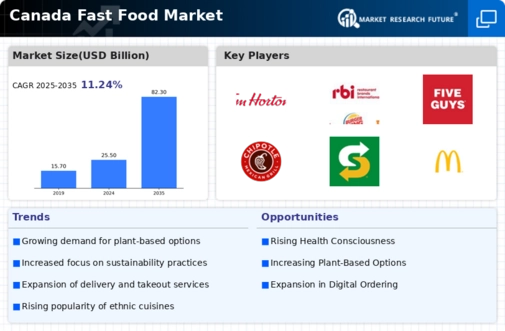The fast food market in Canada is characterized by a dynamic competitive landscape, driven by evolving consumer preferences and a growing emphasis on convenience and quality. Major players such as McDonald's (US), Restaurant Brands International (CA), and Subway (US) are actively shaping the market through strategic initiatives. McDonald's (US) continues to focus on digital transformation, enhancing its mobile app and delivery services to cater to the increasing demand for convenience. Meanwhile, Restaurant Brands International (CA), which owns Tim Hortons and Popeyes, is pursuing aggressive expansion strategies, particularly in urban centers, to capture a larger market share. Subway (US) is also adapting its operational focus by revamping its menu and investing in healthier options, appealing to health-conscious consumers. Collectively, these strategies contribute to a competitive environment that is increasingly centered around innovation and customer engagement.
In terms of business tactics, companies are localizing their supply chains and optimizing operations to enhance efficiency and reduce costs. The market appears moderately fragmented, with several key players vying for dominance. This competitive structure allows for a diverse range of offerings, catering to various consumer segments. The influence of major players is significant, as they set trends that smaller chains often follow, thereby shaping the overall market dynamics.
In October 2025, McDonald's (US) announced a partnership with a leading tech firm to integrate AI-driven analytics into its operations. This strategic move aims to enhance customer experience by personalizing menu recommendations based on purchasing behavior. The integration of AI is likely to streamline operations and improve customer satisfaction, positioning McDonald's (US) as a frontrunner in leveraging technology for competitive advantage.
In September 2025, Restaurant Brands International (CA) unveiled a new sustainability initiative aimed at reducing its carbon footprint by 30% by 2030. This initiative includes sourcing ingredients from local suppliers and implementing energy-efficient practices across its restaurants. Such a commitment to sustainability not only aligns with consumer expectations but also enhances the brand's reputation, potentially attracting environmentally conscious customers.
In August 2025, Subway (US) launched a new marketing campaign focused on its fresh ingredients and healthier menu options. This campaign is designed to counteract the perception of fast food as unhealthy, appealing to a growing demographic that prioritizes health and wellness. By emphasizing quality and freshness, Subway (US) aims to differentiate itself in a crowded market, potentially increasing its customer base.
As of November 2025, current trends in the fast food market include a strong focus on digitalization, sustainability, and the integration of AI technologies. Strategic alliances are becoming increasingly important, as companies collaborate to enhance their technological capabilities and sustainability efforts. Looking ahead, competitive differentiation is likely to evolve from traditional price-based competition to a focus on innovation, technology, and supply chain reliability. This shift suggests that companies that prioritize these areas will be better positioned to thrive in an increasingly competitive landscape.























Leave a Comment